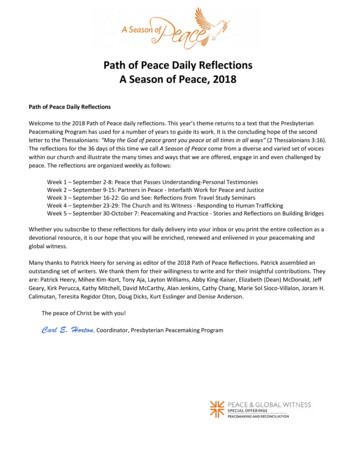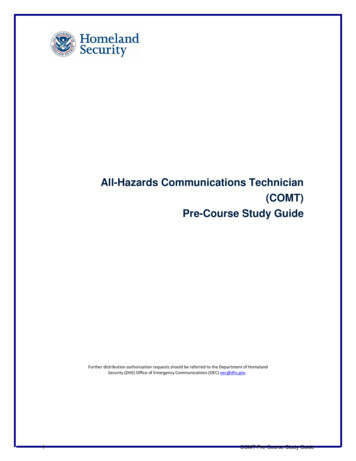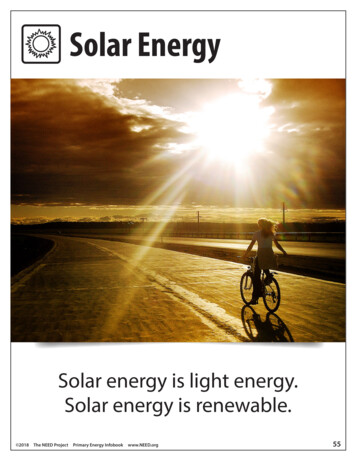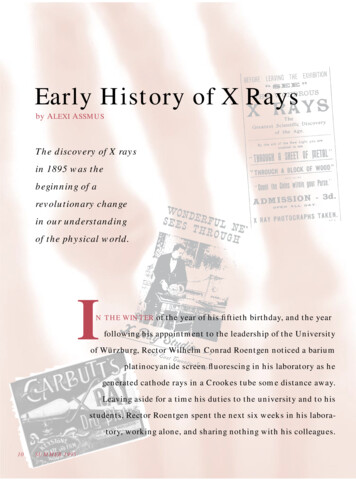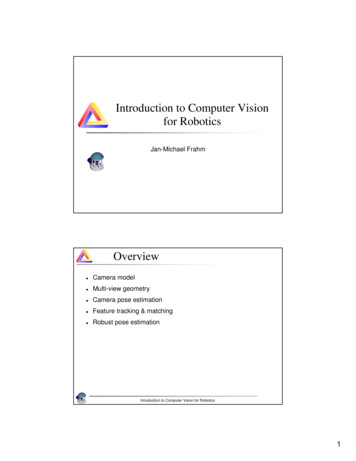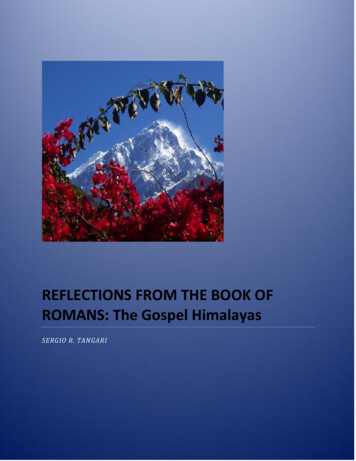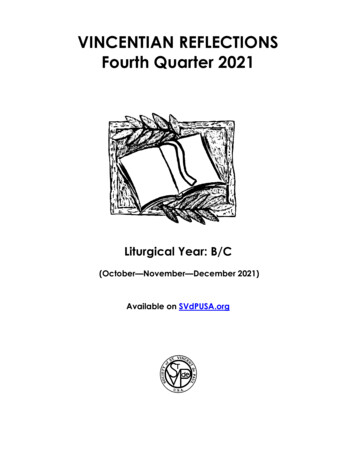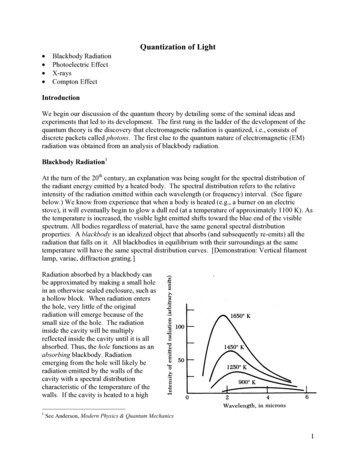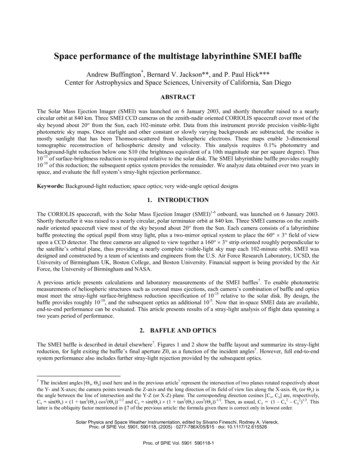
Transcription
Light rays and reflections Concept of light rays– What Geometrical Optics covers Key terms – point source, light ray– Pinhole camera Key terms- real image, aperture stop, object and imagedistance, magnification Law of reflection– Flat surfaces virtual images, field stop– Curved surfaces, specular and diffuse reflections– Approximations for spherical mirrors Imaging formula aberrationsDecember 02LASERS 51
Geometric Optics is Easy BecauseLight Rays Simple Laws:I.Light travels in a straight line known from everyday experiencenot true over long distances or for small beams regime of validity defines geometrical opticsII. The eye sees the rays which enter itIII. Light reflected from shiny smooth surfaces obeysa simple law of reflectionIV. Light crossing the boundary between two differenttransparent materials changes its directionDecember 02LASERS 51
Shadows show some properties of lightLight bulbCard with holescreen(Mask, aperture) Light originates at a source (light bulb) Travels to the screen Blocked by the card except where there is a holeDecember 02LASERS 51
Using two apertures allows isolation of asingle light ray First aperture passes light from one point on candle Second aperture passes light in a single direction Concept of a light ray arises from this idea– Light travelling in many directions from several points consistsof many rays, using aperture we can isolate a single ray– Only an approximation, but often a very good oneDecember 02Light is emitted in alldirections by each pointof the candleUsing a pair ofapertures we cantry to isolate singleray of thislightLASERS 51
Concept of point sourceSmall point of lightEmits light rays in alldirections “Small” here means small angle as seen byobserver– A star is a very large object, but is a point source to anobserver on earth Extended source is made up of many point sources– For example, candle of previous viewgraphDecember 02LASERS 51
What we seelyLight directourcestniopmofrScatteredlight Some rays from the point source enter thepupil of the eye– Brain interprets this, i.e. if from nightsky interpreted as star Light scattered from an object can also enter the eye– The scattering object can be considered a light source alsoDecember 02LASERS 51
Simple raytracing Each point in the sourcesends a ray through eachpoint in the hole on the mask The pattern on the screen hasfeatures due to the source andfeatures due to the mask– The smaller the hole in themask the the more the patternon the screen looks like thesource– the smaller the source, themore the pattern on the screenresembles the hole in the maskDecember 02LASERS 51
Large source, small hole gives an imageof the source Each point of the source gives aspot of light on the screen withthe shape of the hole Little of the light emitted by thesource is collected on the screen– image is very dim More light can be collected bymaking the hole larger– the image is then smeared Pinhole camera (camera obscura)– large depth of field– low aberration– works for all wavelengthsDecember 02LASERS 51
Pinhole cameraSmall cone ofrays from objectObjectdistance, sImagedistance,s’ Image formed on screen is inverted and real– Size depends on s and s’, magnification -s’/s Image is not very bright (small aperture stop)– Only a small cone of rays gets to image– A larger pinhole gives a blurier, but brighter imageDecember 02LASERS 51
Pinhole photographDecember 02LASERS 51
Reflection at plane surface - notationΘDecember 02Θ angle ofincidence The incidence angle isalways measured from thesurface normal, thus normalincidence means Θ 0 For now consider Θ toalways be positiveLASERS 51
Law of reflection has two partsΘ Θ1) The reflected angleequals the incidenceangle2) The incoming ray,the reflected ray andthe surface normal alllie in the same planeSecond part seems obvious on a flat diagram.However, in a complex three dimensional opticalsystem, it is very important.December 02LASERS 51
Smooth and rough surfaces Specular reflection– Surface normal direction almost the same for nearby rays– Surface is shiny, mirrorlike Diffuse reflection– Even very nearby rays reflected in very different directions– Reflection visible from all directions like a screen LASERS 51December 02
Reflection of rays from point sourcePointsource Rays appear to radiate from animage pointimage distanceobject distance– all rays from mirror come fromsame pointImage Image located on same surfacenormal as object and at samedistance behind reflectingsurface as object is in front Called a virtual image becauserays don’t actually come fromthe perceived image location– Cannot be projected on screenDecember 02LASERS 51
Rays entering the eye allow the object to Mirror surface doesn’t be seenhave to be directly in frontof the object–Reflection on a clear lake–Image will be seen if somerays from reflection entereyeThis observersees image Alternative way to determineif image will be seen– Suppose object really exists atimage location; mirror surfaceThis observer is a windowdoesn’t see – The “clear aperture” of theimagemirror is an example of a fieldstop (something that limitsfield of view)December 02LASERS 51
The mirror must be at least half thesize of the object for the entire imageto be seen The portion of theobject which canbe seen is calledthe field of view The edges of themirror that limitthe field of view iscalled the entrancewindowDecember 02LASERS 51
Multiple reflections1object2Image seenin mirror 1Image seenlooking inmirror 2 atdouble bounce Image from multiple reflection can be found bytracing rays through multiple bounces Alternately, consider the image formed by firstmirror as the object for the second mirror In addition to images illustrated here there are:– Direct (one bounce) image in mirror 2– Images from more than 2 bouncesDecember 02LASERS 51
Multiple reflections – a more complex casemirrorr or2mir11 Object representedas an arrowobject13Kaleidoscope invented byBrewster (ca 1830)December 02– Can be anyextended sourcemirror222 Each image canserve as an objectfor anotherreflectionLASERS 51
Reflection at curved surfacesSurfacenormalsDecember 02 Surface normal is found byconsidering a very smallarea around the pointwhere the ray is incident Law of reflection is samewith respect to localnormal as it is for planesurfacesLASERS 51
Imaging with a spherical mirrorRBObject hAOptical axisAB AB’B’Mirrorsurface –sphereEGCenter ofcurvatureCh’FNote: line fromcenter of sphere isperpendicular tosphere surfaceImageqp Two rays are easily traced– ray through center of curvature hits mirror at 90 , retraces path– ray hitting mirror on optic axis reflects on opposite side of axis– other rays can be traced graphically AB’C and EFC are similar triangles ABG and EFG are similar trianglesDecember 02h′ q h pp R h p R q h′ qLASERS 51
Imaging laws for spherical mirrormagnificationh′ qm h pimage location1 1 2 p q R Object at p infinity focuses at q R/2 Define focal length, f R/2 Is this really an image?– for plane mirror, every ray from a point on the objectcomes from the image point– this is only approximately true for the spherical mirror– the deviations from a perfect image are called aberrations Image can be real (q 0) or virtual (q 0)December 02LASERS 51
Imaging with spherical mirror – example400mmObject h 5mmOptical axisGCenter ofcurvatureEh’FImageq600mmRf 200mm2111 600mm q 200mm13121 q 600mm 600mm 600mm 300mmq 300mmDecember 02 Negativemagnification meansCimage is inverted The image is real inthis case, but can bevirtual Convex mirror treatedby making R negative– Sign conventionstreated more later300mm 0.5600mmh 0.5 * h 2.5mmm LASERS 51
A first example of aberrations – sphericalaberrationExact, graphicalraytrace for threerays from a point atinfinity The rays do not all intersect at any point– There is no image (at least not exactly)– Rays closer to the optic axis are close to expected position– A parabola would image these rays perfectly but only for an object on axis at infinityDecember 02LASERS 51
single light ray First aperture passes light from one point on candle Second aperture passes light in a single direction Concept of a light ray arises from this idea – Light travelling in many directions from several points consists of many rays, us
